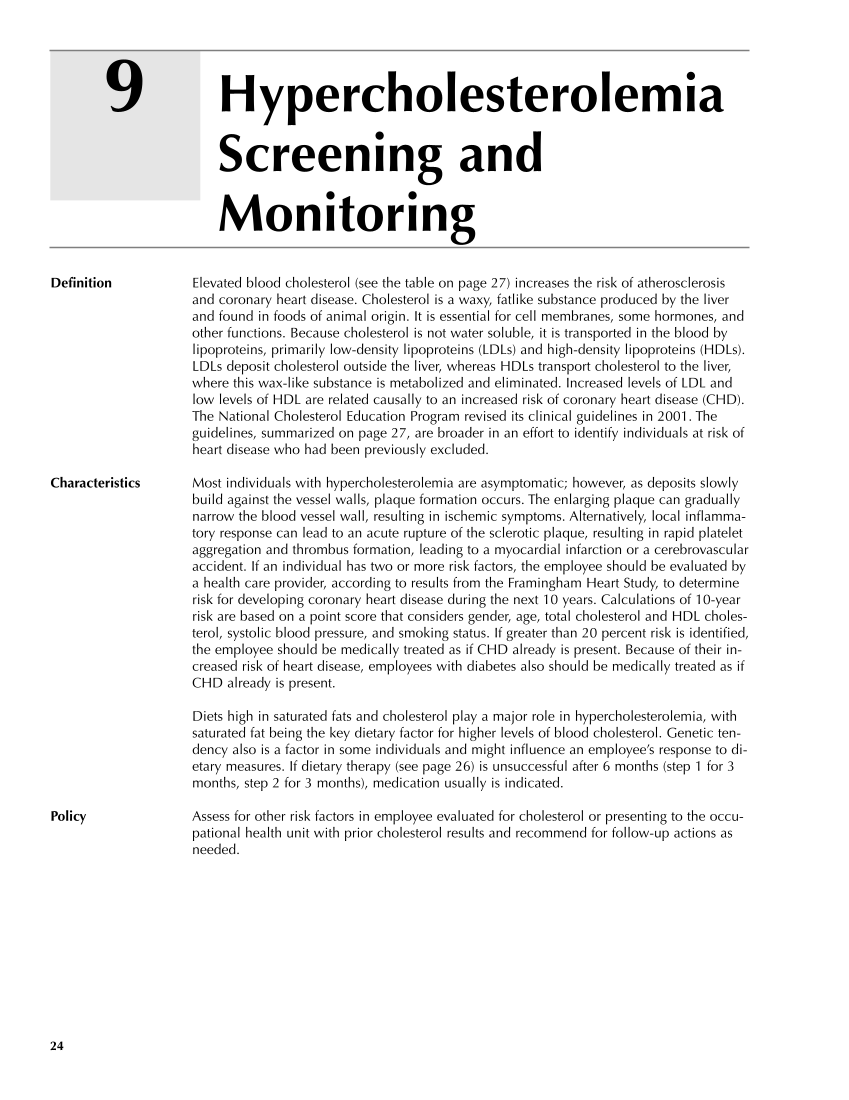9 24 Definition Elevated blood cholesterol (see the table on page 27) increases the risk of atherosclerosis and coronary heart disease. Cholesterol is a waxy, fatlike substance produced by the liver and found in foods of animal origin. It is essential for cell membranes, some hormones, and other functions. Because cholesterol is not water soluble, it is transported in the blood by lipoproteins, primarily low-density lipoproteins (LDLs) and high-density lipoproteins (HDLs). LDLs deposit cholesterol outside the liver, whereas HDLs transport cholesterol to the liver, where this wax-like substance is metabolized and eliminated. Increased levels of LDL and low levels of HDL are related causally to an increased risk of coronary heart disease (CHD). The National Cholesterol Education Program revised its clinical guidelines in 2001. The guidelines, summarized on page 27, are broader in an effort to identify individuals at risk of heart disease who had been previously excluded. Characteristics Most individuals with hypercholesterolemia are asymptomatic however, as deposits slowly build against the vessel walls, plaque formation occurs. The enlarging plaque can gradually narrow the blood vessel wall, resulting in ischemic symptoms. Alternatively, local inflamma- tory response can lead to an acute rupture of the sclerotic plaque, resulting in rapid platelet aggregation and thrombus formation, leading to a myocardial infarction or a cerebrovascular accident. If an individual has two or more risk factors, the employee should be evaluated by a health care provider, according to results from the Framingham Heart Study, to determine risk for developing coronary heart disease during the next 10 years. Calculations of 10-year risk are based on a point score that considers gender, age, total cholesterol and HDL choles- terol, systolic blood pressure, and smoking status. If greater than 20 percent risk is identified, the employee should be medically treated as if CHD already is present. Because of their in- creased risk of heart disease, employees with diabetes also should be medically treated as if CHD already is present. Diets high in saturated fats and cholesterol play a major role in hypercholesterolemia, with saturated fat being the key dietary factor for higher levels of blood cholesterol. Genetic ten- dency also is a factor in some individuals and might influence an employee’s response to di- etary measures. If dietary therapy (see page 26) is unsuccessful after 6 months (step 1 for 3 months, step 2 for 3 months), medication usually is indicated. Policy Assess for other risk factors in employee evaluated for cholesterol or presenting to the occu- pational health unit with prior cholesterol results and recommend for follow-up actions as needed. Hypercholesterolemia Screening and Monitoring
Purchased from OEM Press by (ge corporate access). (C) 2013 OEM Health Information, Inc. All rights reserved.












































































































































































































































































































































































































































